

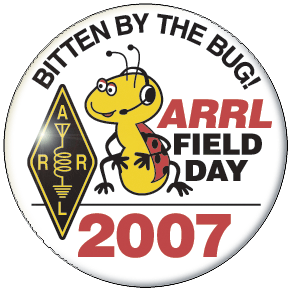
Field Day is an ARRL sponsored operating event intended to test emergency preparedness. The two day event is held on the
last weekend of June with literally thousands of individuals and clubs "heading for the woods" to set up amateur radio
stations operating on emergency power.
The RARC field day event this year was a smashing success,
operators, and bystanders all got a taste of what Ham Radio can be
under abnormal circumstances. The point of Field Day is to simulate a
catastrophic emergency where permanent structures and systems are
unavailable and the Ham must fend for themselves. We operated from the
Cahill farm in south-east Minnesota for the year 2007 event, using no
power from the electrical grid to run the radios, instead we relied on
generator and battery power. Yes we even used solar power! This year
the RARC chose the 3A category for entry. One Morse Code (CW) station,
one Voice (SSB) station, and one digital (PSK31) station were in
operation at the same time. The bonus "Get-On-The-Air" (GOTA) station
doesn't count towards the transmitter class, but instead is there as a
'free' station, to allow non-hams or those who don't operate HF much,
to make contacts under MUCH less stressful circumstances. Peter N8MHD
operated his own station under his call sign at "QRP" or low-power
levels. We also put together and operated a VHF station for a good part
of the contest, Mel, KC0P, headed up the VHF operation in what I call
the "Mel-mobile" pictured here. This station attempted contacts with both the International
Space
Station (ISS) and OSCAR satellites. We were able to hear at least one
satellite, but were unable to complete a contact. Mel brought along
equipment for 50mhz, 146mhz, 440mhz, 1.2ghz, and 10ghz. We completed
contacts on multiple bands, and even tried a "DX" contact on 10ghz with
a station out of the twin cities. I enjoyed watching Mel methodically
make a contact with one station on about 4 different bands, each time
agreeing on a frequency and who would call first, and just-like-that he
would log them. It wasn't quite the 50-60 contacts per hour we were
experiencing on the "big" HF stations, but he rolled them in just the
same. Field day is all about improvisation, you make things up as
you go.
The ladder makes a very convenient antenna tower when lashed to
something relatively solid. We also put a high definition UHF tv
antenna up on a hay wagon, its front guard rail provided the lashing
point. When you're operating under "Emergency" conditions, you get to
make up new ways to do things. The recent hurricane disasters brought
standard communication infrastructure down completely. A hurricane
doesn't spare ham radio towers either, so one has to make-do. During
the event the G5RV antenna designated for the digital station broke,
and we had to improvise another dipole and support it. So far we
haven't attached a lawn chair as an antenna, but that is on my list of
"things to try." The afternoon began at 1:00, with a sudden awakening of the
bands to
the "CQ Field Day" of probably every serious operator in the western
hemisphere. Operators frantically try to make contact with as many
stations as possible in 24 hours. Field day could never happen without
equipment and of course FOOD!!! The RARC and its members would like to
thank the following sponsors who provided this most important aspect of
field day: The Rochester Amateur Radio Club, WØMXW, KØRGR
(GOTA) and N8MHD (QRP)
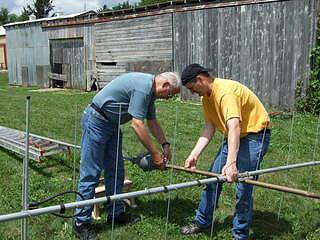 Bill
KCØWIM and Doug KDØUGB assembling the 2m VHF antenna.
Bill
KCØWIM and Doug KDØUGB assembling the 2m VHF antenna.
(KCØWIM photo).
 Mel
KCØP's VHF station. (KCØWIM photo)
Mel
KCØP's VHF station. (KCØWIM photo)
 How many hams does it take
to put up an antenna? Art
KCØJKP, Mike NØMGY, Doug KDØUGB, Don KC0TST, and
Pat NØADQ on ladder. (KCØWIM photo)
How many hams does it take
to put up an antenna? Art
KCØJKP, Mike NØMGY, Doug KDØUGB, Don KC0TST, and
Pat NØADQ on ladder. (KCØWIM photo)
|
|||||||||||||||||||||||||||||
 Peter WØSA at the CW station. (KØMD photo) This station consisted of an Icom 756ProIII and Tokyo Hy-Power amplifier, putting out ~600w of cw into vertical dipoles for 20 and 40 meters (14 and 7mhz respectively.) The station was under computer control, saving many thousands of dits and dahs on the paddles. Fred, K4IU, Peter N8MHD, Scott WØMD, and of course Peter Cross WØSA manned the CW station. Why use Morse Code now you ask? Well, they made 1381 contacts, while the voice and digital stations combined only made 1187 contacts. Throughout the course of the contest, these guys just kept plugging away, running our total score up 2 points at a time. It really pays to have a good CW operator or six! My favorite station was the voice station, because of course anybody can sit down and operate. I'm not so fast with morse code. An Icom 756Pro and SB-220 amplifier fed this 3 element beam antenna with 800-1000w. It was interesting to listen to the generators straining under the load of each station. One needs a very stiff power supply to make a 1500w amplifier put out 1500w (the legal limit for those non-hams reading this).  Main antenna for the HF Phone
station (KGØKJ photo) Main antenna for the HF Phone
station (KGØKJ photo) I personally racked up a couple of hundred contacts in the wee-morning hours, and logged #799 before the caffinated beverages quit working and I headed home. There was many other operators including but not limited to: Dave KØVH, Scott WØMD, BJ, KCØNPF, Pat, NØADQ, and [others]. This year's strategy was to hold a frequency and wait for the contacts to come to us, rather than 'hunt and pounce' operation which we've used in years past. Pat noted that this year our contact levels were about 20% higher than in years past, so something worked. 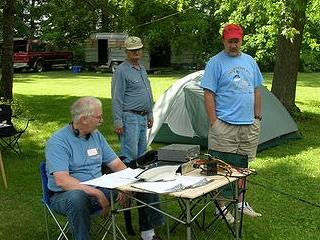 Peter N8MHD at his call
separate QRP Elecraft K2
station; Randall (listening station) and Bob
ABØBW look on.
Peter took the opportunity for some tent camping. Peter N8MHD at his call
separate QRP Elecraft K2
station; Randall (listening station) and Bob
ABØBW look on.
Peter took the opportunity for some tent camping.
(KGØKJ photo) Of course, 1000w makes it easier to contact stations, but
that's not
the only way to go. Peter N8MHD operated the entire contest at 5w,
operating an Elecraft K2 off of a solar charged battery. The solar
panel was enough to operate the radio while receiving, the battery was
necessary for transmission and when a cloud rolled by.
|
|||||||||||||||||||||||||||||
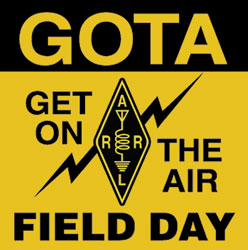 GET ON THE AIR (GOTA)!!! There is no morse code test for those non-hams reading this!! Ham licenses have never been easier to get. The entire purpose of this station is to allow new hams, or non-hams to operate at field day without pressure. The contacts don't roll in at 60 per hour, they come in as slow as you want, and there's an "Extra" class ham operator there to coach you too! Next year GET ON THE AIR at field day! LET'S EAT! The under-21 group around the much anticipated Famous Dave's BBQ Sandwiches! KCØWIP did a little work behind the scenes, and as a result, we were able to munch on GREAT food from Subway, Famous Dave's, Panera, and Baker's Square. Here you see a few of the younger folks grabbing a bite to eat for dinner after a busy afternoon. Around dinner time, we received a visit from Councilman Bob Nowicki. It seems that no matter where I go, Bob pops up somewhere. It's great to see our local leaders taking an interest in ham radio. The general feeling among most government officials is that ham radio is old and antiquated. This is simply not the case, our rigs are computer controlled, and can communicate everything from morse code to pictures. E-mail is faster, except when it doesn't work. Then the hams kick in, and yes, we can still send pictures without the internet, and did so at field day. Hey look at what we can't do! to the right you see KC0UTI and KC0NPF operating some... toys!! Another hobby of mine is top spinning. What you see in the picture is a "diabolo" and yes that's Spanish for devil. They're quite the fun toy to be able to play with, and I've spent a few years learning. The beautiful YL is also learning, and she can toss these around quite accurately. |
|||||||||||||||||||||||||||||
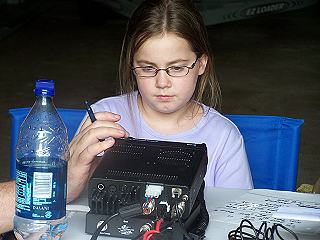 Sarah KC0ZNB at the GOTA station. (KØMD photo) 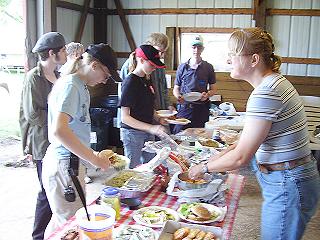 Let's eat! (KCØGND photo)  Club officers with Rochester City Council guest Bob Nowicki (black shirt). (ABØBW photo) |
 "BJ" KCØNPF and Stephanie KCØUTI experiment with new antennas?? (KCØGND photo) 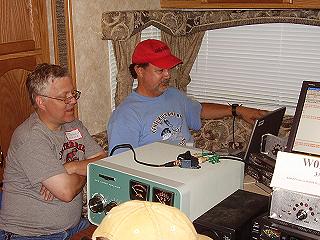 Don KCØQGB and Bob ABØBW at the HF PSK31 digital station. (KCØGND photo)  KariAnn KCØWIP and daughter with Scott KØMD and his daughters Sarah KC0ZNB (l.) and Katie K0KEW (rt.). (KCØGND photo) |
||||||||||||||||||||||||||||
|
As I finish up, I can't help
commenting on the
weather this year. I wasn't sure it was really field day because for
the first time that I remember (well ok, the 3rd time I've actually
been
to field day), it DIDN'T RAIN!! At least, Don, KCØQGB and others
were out weather spotting before field day, that makes it official.
Above right you see Don and Bob, ABØBW at the controls of
the
digital HF station. They came up with a good stack of contacts this
year as well, despite the "minor antenna mishap." (Say that 10 times
fast!) The general atmosphere was fun and exciting, and since I can
only speak for me, I'll be there next year!!! Story by KCØNPF Field Day
report – the QRP station: |
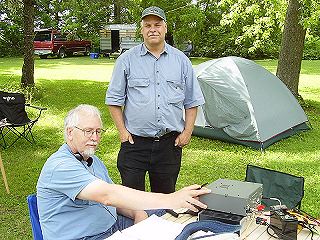 Peter N8MHD at his QRP station; Tom KGØKJ looking on. (KCØGND photo) Overall, the results were mixed. Lots of things worked well. Lots of people came by and talked about the set-up, a couple of people tried operating QRP, and the antennas stayed up The midnight sky and the dawn mist were both exceptional. On the other hand, not very many QSOs were completed. The final tally was 46 CW QSOs, 26 SSB, and 5 PSK-31, for 640 points. With 1150 bonus points, the total claimed score was 1790. Getting almost twice as many bonus points as QSO points is downright embarrassing. Comparing to last year’s scores, this should put us about midway in the 1A class. We might end up first in 1A-Battery in Minnesota! (Last year there were none). The K2 receiver worked very well indeed, and while there was some interference from the other stations, it turned out to be possible to work 20 meter CW while the main CW station was also on 20 meters. Interference from the digital and voice stations was more of an issue, forcing band changes a couple of times. Bob ABØBW and I successfully demonstrated three digital modes (SSTV, Hellschreiber, and MFSK). This contributed 300 bonus points each to WØMXW and N8MHD. Being able to talk it over on the 82 repeater was a big help – we needed lots of fiddling and retries, and it would be much harder to manage the negotiation entirely on HF. Then since the laptop was set up, I made a few QSOs using PSK-31. I learned respect for the number of contacts Bob makes with his station – it’s hard work, and slow. SSB got through on 5 watts better than I expected. Dave KØVH even managed a short S&P run on Sunday morning – very impressive. What about next year? I’d like to do it again. The solar panel worked great, keeping the batteries charged up and powering the radio at the same time. Logging on paper was fine, though typing it all up afterwards was a hassle. The fiberglass mast needed another level of guy ropes, but otherwise held up the antennas well. The antennas worked, but the manual tuner will get replaced by an autotuner, for sure. The mix of CW, Voice, and Digital felt about right. It’s nice to be able to switch between CW and SSB, even though CW (when done right) is clearly the way to get a good score. Using digital for the bonus points and a couple of contacts was fun, but it’s the least efficient of the three modes, by a wide margin. Since it didn’t rain this year, it will certainly rain next year, and the station will need better rain protection – operating from the little tent would have been iffy. Even this year with perfect weather, it would have been good to have some kind of roof, for shade during the day and to protect from the dew as night fell. Thanks again to Pat and Gena for sharing their farm. The setting really contributes a lot. Peter N8MHD
|
RARC Field Day ResultsThe following is a report from Scott KØMD on how well we did at the June Field Day: We placed 215 out of 2333 [total] entries, placed 43 out of 244 Class 3-a entries, I think we did an outstanding job.
That is the listing in the on-line ARRL posting showing 2,723 contacts made as well. I also believe we were the top MN station in the 3A 3 transceiver high power category - great job team! For all the results and a full story from the ARRL, see 2007 ARRL Field Day Results Now Online.
|
RARC Field Day VideoView a time lapse video by NØADQ of the RARC Field Day setup.
|
Last update: November 08, 2007 | |||||||||||||||||||||||||